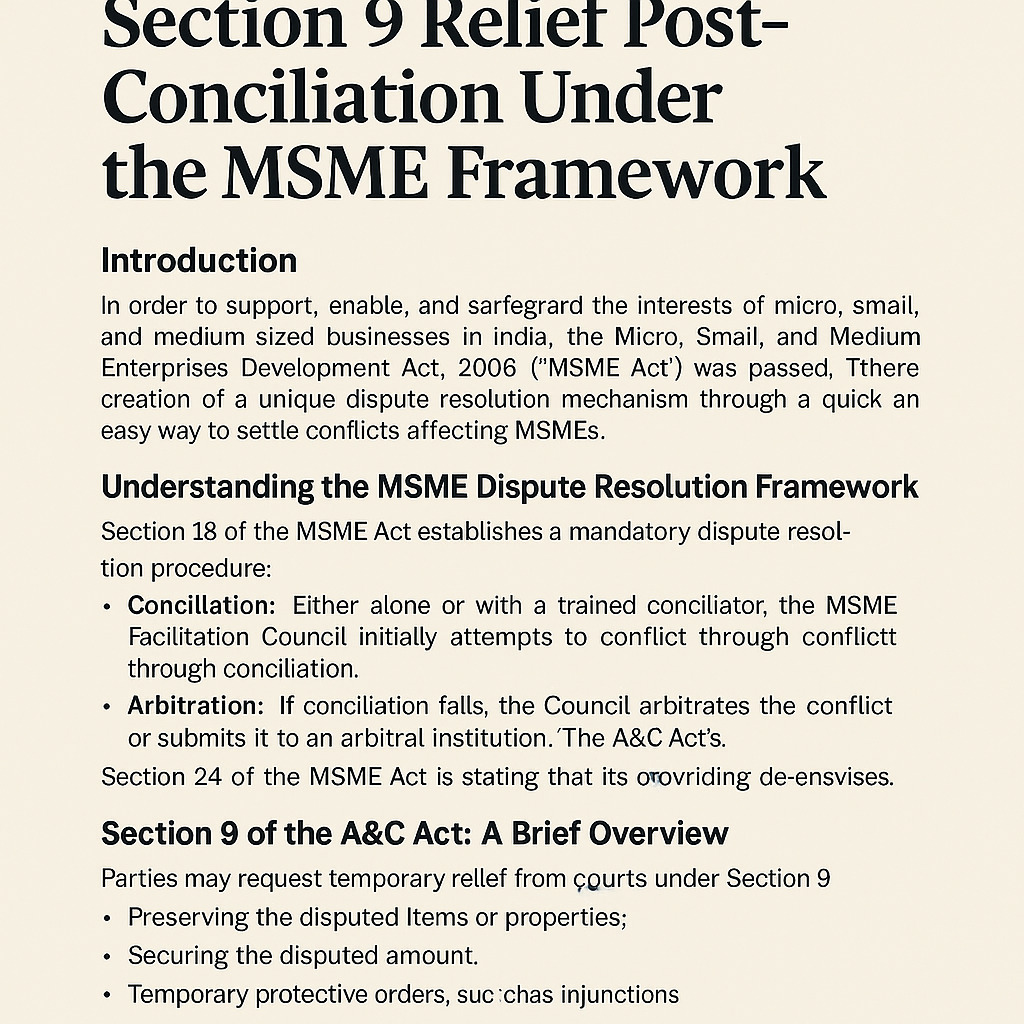View News
No-Easy-Route-to-Courts-Section-9-Relief-Post-Conciliation-Under-the-MSME-Framework

No Easy Route to Courts: Section 9 Relief Post-Conciliation Under the MSME Framework
Introduction
The Micro, Small, and Medium Enterprises Development Act, 2006 (“MSME Act”) was enacted to promote, support, and safeguard the interests of micro, small, and medium enterprises (MSMEs) in India. One of the most significant features of the Act is the establishment of a unique and streamlined dispute resolution mechanism through the MSME Facilitation Councils (MSEFCs), which aims to provide an accessible, cost-effective, and time-bound platform for resolving disputes involving MSMEs.
In parallel, the Arbitration and Conciliation Act, 1996 (“A&C Act”) provides for interim relief through Section 9, enabling parties to seek court intervention for protective measures before, during, or after arbitration proceedings. However, when disputes are already being resolved under the MSME Act framework—specifically when arbitration is initiated following failed conciliation under Section 18—questions arise regarding the compatibility and scope of Section 9 relief.
This article delves into the legal position, judicial interpretations, and the limited availability of Section 9 remedies during ongoing statutory arbitration under the MSME Act. It evaluates why courts have taken a restrained approach and what constitutes the "exceptional circumstances" required to warrant such relief.
Understanding the MSME Dispute Resolution Framework
Section 18 of the MSME Act lays down a mandatory, two-tiered dispute resolution process for claims relating to delayed payments owed to MSMEs:
-
Conciliation: When a dispute arises, either party may approach the MSEFC, which first attempts to resolve the matter through conciliation. This may be conducted by the Council itself or by appointing a qualified conciliator.
-
Arbitration: If conciliation fails, the MSEFC is empowered to either arbitrate the matter directly or refer it to an arbitration institution. In such cases, the provisions of the A&C Act apply to the proceedings.
Critically, Section 24 of the MSME Act gives the statute an overriding effect over any other law that is inconsistent with its provisions. This means that the MSME Act’s dispute resolution process takes precedence, aiming to expedite the resolution of MSME-related disputes while reducing procedural delays.
Section 9 of the A&C Act: Scope and Role
Section 9 of the A&C Act allows parties to seek interim measures from civil courts in the following situations:
-
Before arbitration proceedings commence;
-
During the arbitration proceedings; or
-
After the arbitral award is issued but before its enforcement.
Interim relief under Section 9 may include injunctions, preservation of assets, or securing the amount in dispute. It serves as a crucial safeguard to prevent a party from taking steps that might undermine the arbitration process or render the final award meaningless.
However, the role of Section 9 becomes more complex when arbitration arises from a statutory scheme like the MSME Act. Once arbitration under Section 18(3) is triggered, parties are generally expected to approach the arbitral tribunal under Section 17 of the A&C Act, which grants the tribunal the same powers as a civil court to issue interim measures.
Judicial Interpretation: A Narrow Path for Section 9
Indian courts have consistently held that once arbitration proceedings commence under the MSME Act, the scope for Section 9 intervention is significantly narrowed. Relief under Section 9 is only permissible in exceptional circumstances—where immediate court action is absolutely necessary to prevent injustice or protect the integrity of the arbitration process.
Key Judicial Precedents:
-
Gujarat State Civil Supplies Corporation Ltd. v. Mahakali Foods Pvt. Ltd. (Unit 2) & Ors. (2022):
The Supreme Court emphasized that parties cannot bypass the statutory arbitration process under the MSME Act by seeking interim relief through Section 9. Once arbitration has commenced, relief must be sought under Section 17 unless there is compelling urgency or the tribunal is unable to act promptly. -
Secur Industries Ltd. v. Godrej & Boyce Manufacturing Co. Ltd.:
The Delhi High Court ruled that as soon as the MSEFC assumes jurisdiction under Section 18, the A&C Act (including Section 17) becomes fully applicable. Section 9 can only be invoked in rare situations where interim protection from the tribunal is practically unviable. -
Best Steel Logistics Pvt. Ltd. v. Konkan Railway Corporation Ltd.:
The Bombay High Court reiterated that arbitration conducted after failed conciliation under the MSME Act is to be treated as statutory arbitration. Therefore, judicial intervention under Section 9 must remain the exception rather than the norm.
What Qualifies as “Exceptional Circumstances”?
The courts have laid down certain guiding principles to determine what constitutes "exceptional circumstances" justifying Section 9 intervention:
-
A real and immediate threat exists that may frustrate or derail the arbitration process.
-
There is an urgent risk of asset dissipation or destruction which could nullify the effect of any eventual arbitral award.
-
The arbitral tribunal is either not yet constituted or is unable to act swiftly enough to prevent injustice.
-
Relief from the tribunal would be ineffectual due to practical constraints, including time sensitivity.
Routine commercial urgency, financial inconvenience, or speculative threats do not meet the threshold for invoking Section 9 once arbitration is underway.
Rationale Behind Judicial Restraint
Several compelling reasons underpin the courts’ conservative approach toward Section 9 applications during MSME arbitration:
-
Preservation of the MSME Act's Objectives:
The MSME Act is designed to offer an expeditious, low-cost, and streamlined mechanism for dispute resolution. Allowing frequent court interventions would undermine these legislative goals and bog down the process. -
Effective Tribunal Powers under Section 17:
The arbitral tribunal under the A&C Act has sufficient powers to grant interim relief. There is no inherent need to resort to court intervention unless the tribunal is incapable of acting in a timely manner. -
Respect for Arbitral Autonomy:
Judicial restraint reinforces party autonomy and strengthens the credibility of arbitration as an independent and efficient dispute resolution mechanism. -
Avoiding Duplication and Delays:
Parallel court proceedings create procedural overlap, uncertainty, and delay, which the MSME Act specifically seeks to prevent.
Conclusion
The MSME Act offers a purpose-built mechanism for resolving disputes involving micro, small, and medium enterprises, emphasizing speed, efficiency, and minimal judicial intervention. Once conciliation fails and arbitration is initiated under Section 18(3), parties are expected to channel their requests for interim relief through the arbitral tribunal itself under Section 17 of the A&C Act.
Indian courts have made it clear that Section 9 relief will be granted only in truly exceptional circumstances, where urgent judicial intervention is imperative to protect the integrity of the arbitration process or prevent serious injustice. This judicial approach not only upholds the legislative intent of the MSME framework but also enhances the overall efficiency, credibility, and finality of arbitration proceedings in India.
In conclusion, while Section 9 remains a powerful tool, it cannot be used as a shortcut or parallel remedy when statutory arbitration under the MSME Act is in motion. MSMEs and their counterparties must be prepared to operate within the confines of this streamlined system and seek remedies primarily through the arbitral forum unless faced with extraordinary exigencies.
"Unlock the Potential of Legal Expertise with LegalMantra.net - Your Trusted Legal Consultancy Partner”
Disclaimer: Every effort has been made to avoid errors or omissions in this material in spite of this, errors may creep in. Any mistake, error or discrepancy noted may be brought to our notice which shall be taken care of in the next edition In no event the author shall be liable for any direct indirect, special or incidental damage resulting from or arising out of or in connection with the use of this information Many sources have been considered including Newspapers, Journals, Bare Acts, Case Materials , Charted Secretary, Research Papers etc.
Prerna Yadav
LegalMantra.net Team

